Galápagos Islands
Things to DO
Isla Fernandina
Fernandina is the westernmost island in the Galapagos Islands, the third largest and youngest of the islands, less than one million
years old. It is the most volcanically active and sits at the center of the hot spot that created the Galapagos Islands.
Fernandina is the most pristine of the Galapagos Islands.
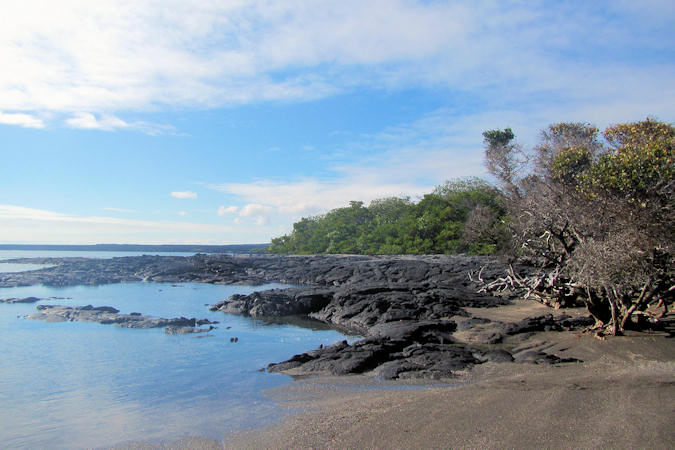 |
|||||
The greatest threat to the flora and fauna is the potential for future introductions of aggressive exotic species.
Periodic monitoring to detect new introductions, especially of rats, must be carried out regularly to ensure the protection of this
environment.
Punta Espinoza
The one visitor site at Punta Espinoza, is a memorable one. Marine Iguanas, too many to count, can be seen sunning themselves on the
black-lava formations, a dramatic sight that looks a museum diorama on dinosaur come to life.
The Marine Iguanas nest here in the early part of the year with young emerging around June. At that time, snakes are commonly seen in the
nesting zone.
A dry landing brings you to two trails: a 250 m. trail to the point and a 750 m. trail to recent formed lava fields.
Here you can see various pioneer plants, such as Lava Cactus. One of the first species to grow on young lava, it can survive with very
little water.
Isla Santiago
Santiago is visited by the majority of tourist boats with wonderful visitor sites at James Bay on the northwest and Sullivan
Bay on the southeast.
The focus of conservation work on Santiago in the last decade has resulted in rapid recovery of much of the vegetation and many of the
native species.
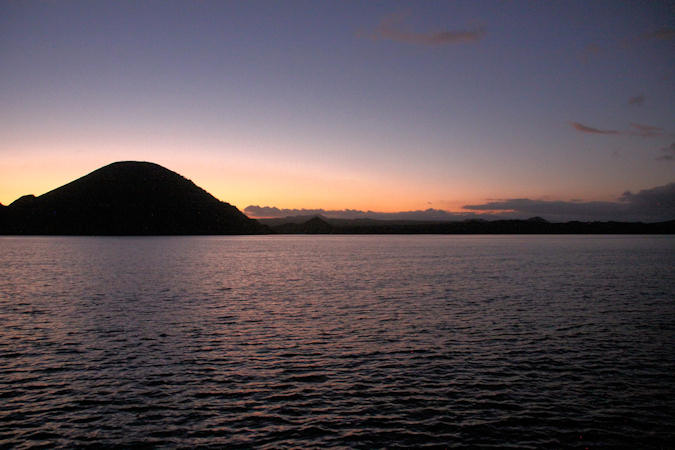 |
|||||
However, the presence of introduced plants and black rats continue to cause problems within the natural ecosystem.
Sullivan Bay
The Sullivan Bay visitor site provides a unique opportunity to walk across a recent lava flow and view its beautiful structural
characteristics.
The lava flow was formed in the second half of the 19th century. As much of the barren, volcanic landscape of eastern Santiago, the trail
at Sullivan Bay crosses relatively flat, black pahoehoe lava, dotted with a series of pyroclastic cones.
Along the inland section of the trail, older, reddish-yellow-colored tuff cones stand out in the middle of the lava flow. Tiny
Mollugo plants can be spotted growing out of the fissures as they begin to colonize this barren terrain.
Although there is little wildlife to speak of and lava is the main focus of the visit – don’t forget to bring your camera.
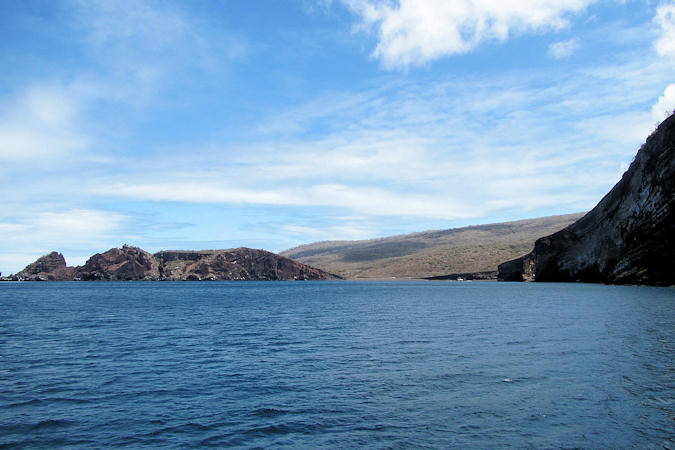 |
|||||
Puerto Egas
One of the most popular sites in all the islands is Puerto Egas at the southern end of James Bay.
It was named after Dario Egas, the owner of a salt mine on the island that was once, as a result of presidential patronage, the
only producer of salt in all the country.
Here, there is a long, flat, black-lava shoreline where eroded shapes from lava pools, caves and inlets house a great variety of
wildlife.
The inlets are favorite haunts of the Galápagos Fur Seals, and this is really a great opportunity to snorkel with this surprisingly agile
animals as well as with many species of tropical fish.
Keep you eyes open for the Munk's Devil Ray, which has been documented to leap out of the water, either alone or in groups,
performing vertical jumps, somersaults and other acrobatic manoeuvres
Isla Sombrero Chino
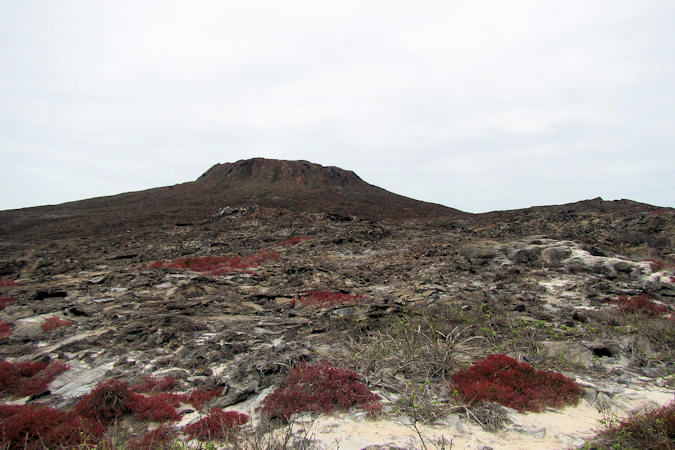 |
|||||
Chinese Hat or Sombrero Chino is a small island approximately 200 m off the southeastern coast of Santiago.
The small channel of turquoise water provides a beautiful snorkeling site, particularly along the Santiago coast where it is possible
to see sharks, sea lions, and rays.
Chinese Hat is a small islet composed of delicate lava and spatter cones. Seen from the north, the small volcanic cone is the shape of a
Chinese Hat.
The short visitor trail runs along the west coast of the island. Galapagos Hawks, Lava Heron, Small Ground Finch and Galapagos Dove are
often observed in the area.
The Elliot's Storm Petrel can also be seen here. This species feeds largely on the wing, pattering its feet along the surface
and dipping its bill into the water.
The feeding behaviour of the Galapagos subspecies is unusual amongst storm-petrels as it forages close to shore; all other
storm-petrels are exclusively pelagic.
Isla Rábida
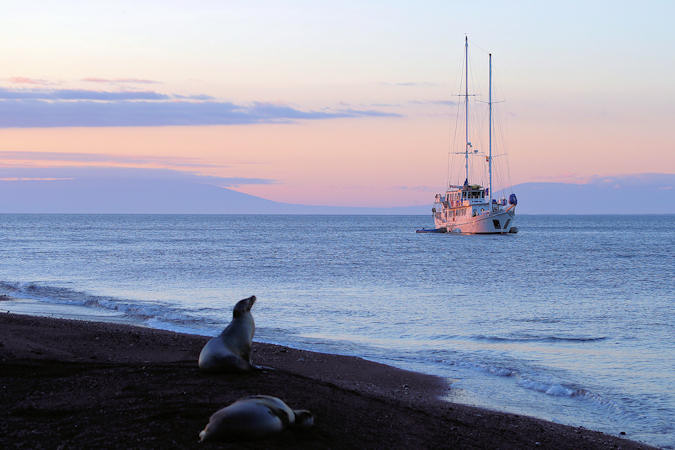 |
|||||
Sitting 4.5 km to the south of Santiago Island, Rábida Island is one of the most volcanically varied islands in the archipelago.
Rábida is a relatively small, arid island with steep slopes. Most of the coastline is rocky except for a beach on the northeast side.
Several small volcanic craters and the high amount of iron in the lava give the island its distinctive red color and overall
appearance.
A visit to Rábida’s begins with a wet landing on the maroon-colored beach on the northern coast. Behind the beach is a saltwater lagoon
that, at times, is a feeding and breeding area for Flamingos. Pintail Ducks and several species of waders are also frequently seen feeding
in the lagoon.
The vegetation consists mainly of Opuntia cacti, Palo Santo trees, and scrubby bushes.
Isla Bartolomé
Bartolomé is the most visited and most photographed island in Galapagos.
Visitors have access to two sites: one that involves a climb to an incredible viewpoint and the other at the beach where snorkeling and
swimming is enjoyed.
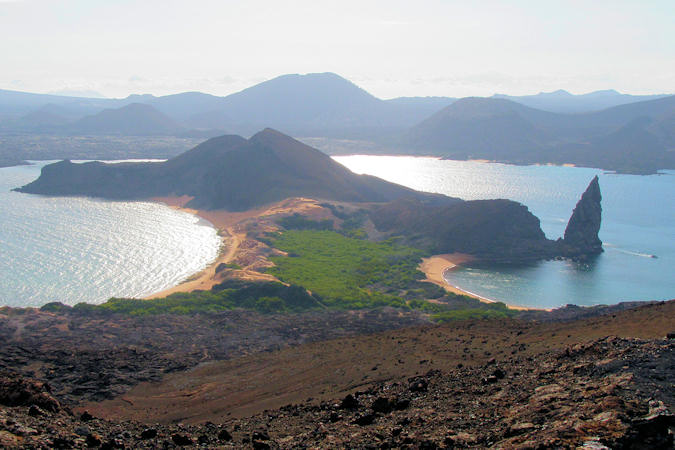 |
|||||
Visitors land across the small bay, opposite Pinnacle Rock.
They proceed to climb a 600-m trail to the 114-m summit. The summit provides spectacular views of Pinnacle Rock, the immense black
lava flows at Sullivan Bay and the rest of Santiago Island
Along the way, various volcanic formations including spatter and tuff cones and lava flows are seen. The climb also gives the visitor a
unique insight into species adaptation. The Tequila plant, which appears to be dead brush, is actually made of leaves covered with
small gray hairs, which help prevent moisture evaporation and reflect sunlight.
The Galapagos Penguins, the second smallest penguin species in the world, have established a small breeding colony in a cave
behind Pinnacle Rock. In 1982, these creatures suffered a massive decline during El Niño when the overall population in Galapagos declined
from nearly 15.000 to fewer than 500 birds and they have been slow to recover.
Isla Genovesa
Genovesa Island is a horse-shoe shaped island located in the northeastern region of the Galapagos Archipelago. Its distinct shape was
formed from the eruption of a shield volcano and the eventual collapse of one side of the caldera.
The resulting submerged crater formed Darwin Bay, which is surrounded by steep cliffs that provide homes for many seabirds.
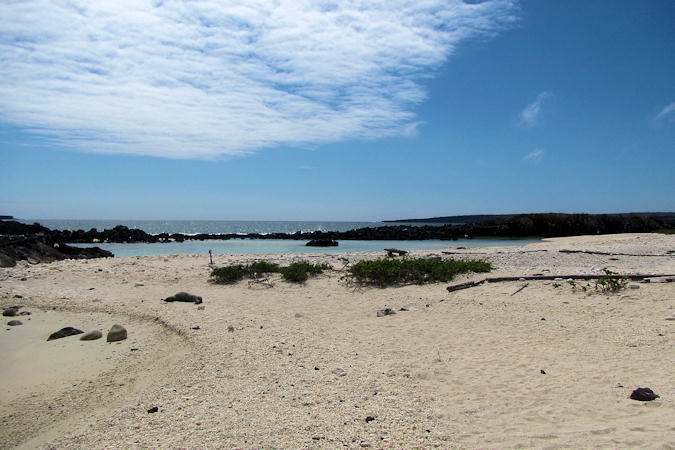 |
|||||
Visitors disembark at Darwin Bay Beach onto a small sand and coral beach.
Sally Lightfoot Crabs can be found on the rocks at the eastern end of the beach.
A short trail heads west along a tidal lagoon and then up a rocky hill that leads to a point overlooking the cliffs and Darwin Bay.
The trail continues through Palo Santo trees, Opuntia cacti, and Saltbushes inhabited by Great Frigatebirds and Red-footed Boobies.
This is one of the few places in the islands where visitors are guaranteed to see Red-footed Boobies. It is estimated that more than
200.000 Red-footed Boobies live in the trees and bushes of Genovesa.
Snorkeling along the cliffs inside the caldera is exellent. The water is very nutrient-rich, so all types of marine life can be found.
Numerous shark species are present, with hammerheads the most abundant.
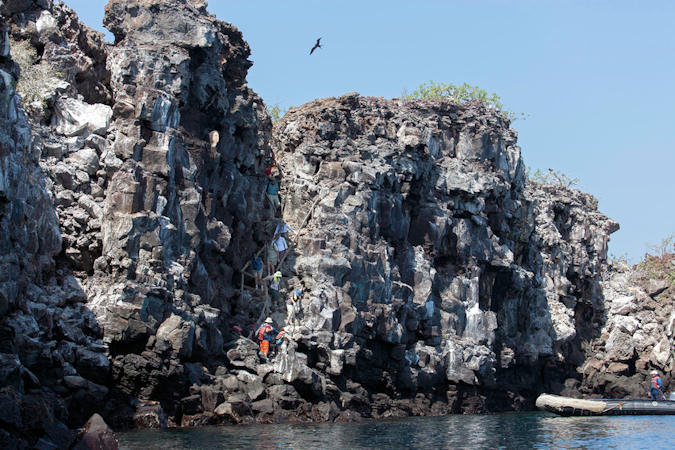 |
|||||
Prince Philip’s Steps
On the dinghy ride to and from the Prince Philip’s Steps, visitors will marvel at the variety of sea life using the crevices of the lava
cliffs for shelter. Red-billed Tropicbirds fly overhead, darting between their nests and the bay, and a small colony of fur seals may be
found near the landing site.
Visitors are dropped off at a steep stairway that begins on rocks at the foot of a path that leads through a seabird colony full of
Nazca and Red-footed Boobies. Once visitors reach the plateau, the trail continues inland and there it's possible to see some finches
thin Palo Santo forest.
Near the end of the trail, visitors can look out over a rocky lava plain where Wedge-rumped Storm Petrels fly in all directions.
Unlike other petrels, these birds are unique because they are active during daytime and return to their nests in the evening to avoid
their predators.
Lucky visitors with keen eyes may catch a glimpse of a Short-eared Owl stalking its petrel prey along the island’s eastern cliffs.